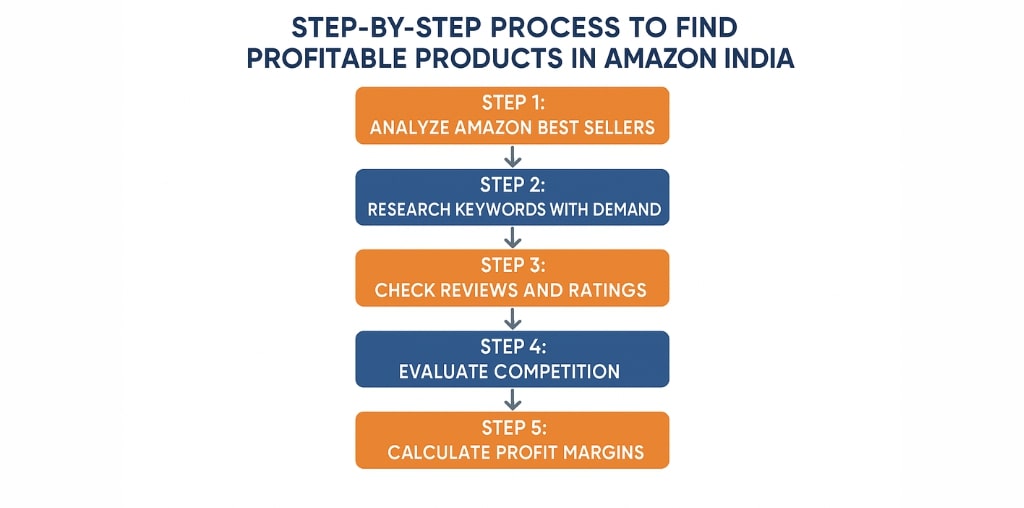Table Of Content
- Why Finding Winning Products Matters
- Key Traits of a “Winning Product” on Amazon India
- The Step-by-Step Method to Find Winning Products
- Step 1: Start With Marketplaces
- Step 2: Check Search Volumes
- Step 3: Analyze Competitors
- Step 4: Calculate Profit Margins
- Step 5: Validate With Trends
- Free and Paid Tools to Help Your Product Hunt
- Free Tools
- Paid Tools
- Amazon Categories Worth Exploring in 2025
- Common Mistakes to Avoid
- FAQs
- Final Thoughts
Finding winning products to sell on Amazon India has become both an art and a science in 2025. With intense competition and an ever-evolving Indian e-commerce landscape, sellers must look beyond generic trends and dive deep into product research, keyword analysis, and consumer behaviour.
Whether you’re a new Amazon India seller launching your first listing or an experienced merchant aiming to expand your catalogue, identifying profitable products is crucial for building a sustainable and successful Amazon business. In this ultimate guide, we’ll show you actionable methods, free and paid tools, and expert tips to help you discover best-selling products on Amazon India, tap into high-demand niches, and stay ahead of the competition.
Why Finding Winning Products Matters
Many new sellers jump onto Amazon India believing success comes from simply listing any product. The truth is, product selection is everything.
- A great product practically sells itself
- A poor choice drains your capital and time
In 2025, Indian customers are more savvy, and competition is stiffer than ever. You need to know:
- How to spot demand
- How to avoid saturation
- How to identify genuine gaps in the market
Key Traits of a “Winning Product” on Amazon India
Not every trending product is profitable. A winning product often has:
- Consistent demand → Not seasonal or fad-based
- Low-to-medium competition → Avoid saturated niches
- Good profit margins → Enough to cover fees, ads, and returns
- Lightweight & easy to ship → Lower shipping and storage costs
- Low return rate → Avoid products prone to defects or dissatisfaction
- Room for differentiation → Customizations, bundles, better quality
The Step-by-Step Method to Find Winning Products

Here’s a proven process Indian sellers can follow:
Step 1: Start With Marketplaces
Browse Amazon.in:
- “Best Sellers” lists
- “Movers and Shakers” pages
- “New Releases” sections
These pages tell you:
- What’s trending right now
- Which categories are heating up
- How fast products climb in rankings
Step 2: Check Search Volumes
Use tools like:
- Google Keyword Planner
- SEMrush or Ahrefs (for Amazon keywords)
- SellerApp or Helium 10 India databases
Look for:
- Keywords with 5,000–50,000 monthly searches
- Lower keyword difficulty scores
Step 3: Analyze Competitors
Pick any potential product and check:
- Number of sellers
- Number of reviews (ideally fewer than 500 for new sellers to compete)
- Pricing patterns
- Brand dominance (Avoid categories ruled by big brands)
Step 4: Calculate Profit Margins
Calculate:
Selling Price – (Amazon fees + Shipping + Product Cost + Ads) = Profit
Look for:
- At least 20–30% net margin after costs
- Products under ₹2,000 often convert faster but offer lower margins
Step 5: Validate With Trends
Check:
- Google Trends → for seasonal dips or surges
- Social platforms → Instagram, YouTube, Pinterest
- News articles → shifts in consumer behaviour
A product booming only because of temporary hype is risky.
Free and Paid Tools to Help Your Product Hunt
Free Tools:
- Amazon.in Best Sellers pages
- Google Trends
- Google Keyword Planner
- Amazon search autocomplete suggestions
Paid Tools:
- SellerApp → tailored to Indian Amazon data
- Helium 10 → excellent for deep analysis, now more India-friendly
- Jungle Scout → also expanding Indian data
- Ahrefs → good for keyword research around products
- Keepa → for price history and trends
Amazon Categories Worth Exploring in 2025
Some categories are growing faster than average in India:
- Home & Kitchen
- Fitness & Sports Accessories
- Toys & Games
- Pet Supplies
- Beauty & Personal Care
- Car Accessories
- Health Supplements (if compliant with regulations)
- DIY tools and craft supplies
These niches often:
- Attract consistent demand
- Allow room for private label differentiation
- Have high repeat purchase rates
Common Mistakes to Avoid
- Chasing viral products without research → You’ll enter a price war
- Ignoring reviews → Bad reviews often signal manufacturing or quality issues
- Not calculating costs thoroughly → Fees and ads eat margins quickly
- Overestimating your budget → Always test small before bulk orders
- Selling highly regulated products → Supplements, electronics, and cosmetics often need approvals
FAQs
Which product categories are oversaturated on Amazon India?
Phone accessories, generic fashion jewelry, and mass-market electronics are extremely competitive unless you can uniquely differentiate.
What’s the best price range for new sellers?
Products between ₹300 and ₹2,000 tend to sell faster and have manageable risk for beginners.
Do I need to do private label to succeed?
Not necessarily. But private label gives you brand control and better margins in the long run.
Are tools like Helium 10 worth it for India?
If you’re serious about Amazon as a business, yes. Tools save time and reduce guesswork.
Can I sell internationally from Amazon India?
Yes, through Amazon Global Selling. However, it requires separate registration, compliance, and logistics planning.
Final Thoughts
Finding a winning product on Amazon India isn’t luck—it’s a science.
- Start with trends
- Validate demand with data
- Analyze competition
- Protect your margins
India’s e-commerce boom is creating endless new opportunities. But only those who do their research and stay agile will truly thrive.
Your next winning product is out there—it’s just waiting for you to discover it.




